We may not have the course you’re looking for. If you enquire or give us a call on +46 850282424 and speak to our training experts, we may still be able to help with your training requirements.
Training Outcomes Within Your Budget!
We ensure quality, budget-alignment, and timely delivery by our expert instructors.
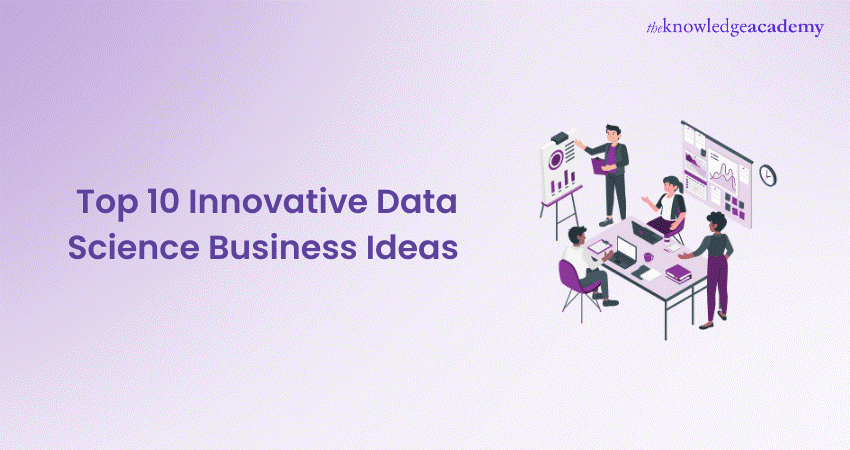
Data has become the backbone of innovation and decision-making in businesses across various sectors. Data Science, with its sophisticated techniques and algorithms, empowers enterprises to extract valuable insights from large datasets, driving informed strategies and improving overall efficiency. You can also use some innovative Data Science Business Ideas to increase your revenue as well as build a loyal customer base. In this blog, we are going to discuss some innovative Data Science Business Ideas so that you can utilise them to strengthen your business.
Table of Contents
1) Importance of Data Science in Modern Business
2) Top Innovative Data Science Business Ideas
a) Predictive analytics for e-commerce
b) Healthcare Data Analysis
c) Personalised marketing solutions
d) Fraud detection in financial services
e) Smart manufacturing and IoT integration
f) Environmental Data Analysis for sustainability
g) Predictive maintenance for industrial equipment
h) Sports analytics and performance enhancement
i) Education technology and personalised learning
j) Cybersecurity threat analysis
3) Conclusion
Importance of Data Science in Modern Business
The importance of Data Science in modern business is crucial. It helps in driving strategic decisions and fostering innovation. Nowadays, data flows incessantly from numerous sources. Companies rely on Data Science to derive meaning from these vast datasets. Through advanced analytics, Machine Learning algorithms, and predictive modelling, it transforms raw data into valuable knowledge.
This helps companies to identify patterns, anticipate trends, and understand customer behaviour in unprecedented depth. Businesses armed with these insights can make informed decisions, optimise processes, enhance customer experiences, and ultimately gain a competitive edge. Moreover, Data Science democratises information, making complex data accessible and understandable, empowering not just large corporations but also startups and small businesses to leverage data-driven strategies.
Learn how to use Data Science effectively with our Data Science Training. Join now!
Top Innovative Data Science Business Ideas
In this section, we are going to discuss some innovative Data Science ideas which you can use for business purposes:
Predictive analytics for e-commerce
Predictive analytics, a subset of Data Science, revolutionises the e-commerce landscape by enabling businesses to anticipate customer needs, optimise inventory management, and enhance overall user experience. Here's how predictive analytics shapes the future of e-commerce, one data point at a time:
1) Customer behaviour analysis:
a) Predictive analytics mines historical customer data to identify patterns and trends in buying behaviour.
b) Understanding which products customers are likely to purchase helps in creating targeted marketing campaigns.
2) Demand forecasting:
a) By analysing past sales data alongside external factors like holidays or seasonal trends, e-commerce businesses can forecast demand accurately.
b) This forecasting aids in inventory management, ensuring products are available when customers want to buy, thus minimising both overstocking and stockouts.
3) Personalised product recommendations:
a) Predictive algorithms analyse a customer's purchase history, browsing behaviour, and preferences to offer personalised product recommendations.
b) This level of personalisation enhances the user experience, increases customer satisfaction, and boosts sales through cross-selling and upselling opportunities.
4) Shopping cart abandonment prediction:
a) Predictive analytics identifies patterns that lead to shopping cart abandonment, such as unexpected shipping costs or a complicated checkout process.
b) By addressing these pain points in real-time, e-commerce businesses can recover potentially lost sales and improve conversion rates.
5) Dynamic pricing strategies:
a) Predictive analytics assesses market demand, competitor pricing, and customer behaviour to adjust product prices dynamically.
b) This data-driven pricing strategy ensures competitiveness and maximises revenue by setting optimal prices based on real-time market conditions.
6) Fraud detection and prevention:
a) Predictive models analyse transaction data to identify fraudulent patterns and prevent unauthorised activities.
b) By detecting and blocking fraudulent transactions before they occur, e-commerce businesses safeguard both their revenue and their customers' trust.
Healthcare Data Analysis
Data Analysis serves as a powerful catalyst, reshaping the industry's landscape and driving advancements in patient care, treatment methodologies, and overall operational efficiency. Here's a comprehensive exploration of how healthcare Data Analysis is revolutionising the sector:
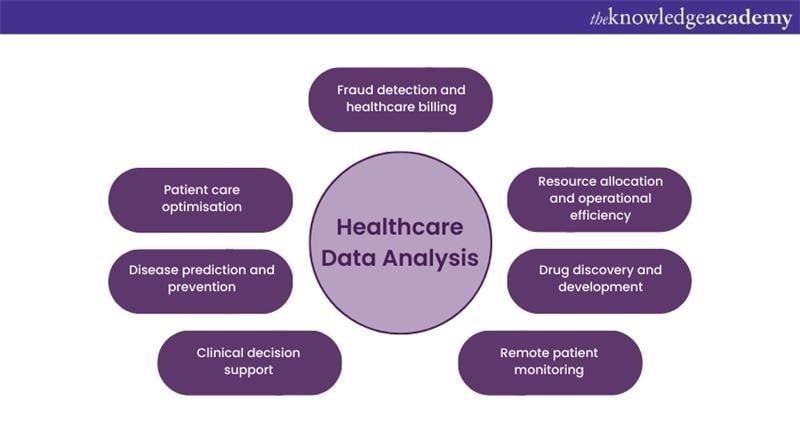
1) Patient care optimisation:
a) Healthcare Data Analysis evaluates patient data, medical history, and treatment outcomes to identify patterns and trends.
b) By understanding these patterns, healthcare providers can personalise treatment plans, ensuring patients receive tailored, more effective care.
2) Disease prediction and prevention:
a) Analysing vast datasets allows healthcare professionals to identify early signs of diseases and predict potential outbreaks.
b) By recognising risk factors in specific demographics, preventive measures can be implemented, reducing the overall disease burden on communities.
3) Clinical decision support:
a) Data Analysis provides clinicians with evidence-based insights, aiding them in making informed decisions about patient diagnosis and treatment.
b) By integrating clinical data and medical research, healthcare professionals can adopt best practices, leading to improved patient outcomes.
4) Resource allocation and operational efficiency:
a) Hospitals and healthcare facilities analyse data to optimise resource allocation, ensuring that staff, equipment, and facilities are utilised efficiently.
b) Predictive analytics assists in forecasting patient admissions, enabling hospitals to adjust staffing levels and resources accordingly.
5) Drug discovery and development:
a) Data Analysis accelerates drug discovery by analysing genetic and biological data to identify potential drug targets.
b) This process expedites research, reduces costs, and enhances the development of novel treatments for various diseases.
6) Remote patient monitoring:
a) Healthcare Data Analysis enables remote monitoring of patients with chronic illnesses.
b) Continuous analysis of patient data from wearables and IoT devices allows healthcare providers to intervene promptly if any concerning trends are detected, enhancing patient safety and well-being.
7) Fraud detection and healthcare billing:
a) Data Analysis is employed to detect healthcare fraud by identifying irregular billing patterns and unusual claims.
b) By preventing fraudulent activities, healthcare organisations can allocate resources more effectively and ensure that genuine patients receive the care they need.

Personalised marketing solutions
Leveraging the power of Data Science and analytics, businesses are now able to understand their customers on a granular level, tailoring their marketing efforts to individual preferences and behaviours. This evolution has reshaped the way products and services are promoted and has profound implications for customer engagement and brand loyalty.
1) Customer profiling and segmentation:
a) Personalised marketing begins with the thorough analysis of customer data, segmenting audiences based on demographics, purchasing history, online behaviour, and preferences.
b) By categorising customers into segments, businesses can create targeted campaigns that resonate with specific groups, increasing the likelihood of conversion.
2) Behavioural tracking and predictive analytics:
a) Advanced analytics track customer behaviour across digital platforms. This data is then analysed to predict future actions and preferences.
b) Predictive analytics enables businesses to anticipate customer needs, allowing for timely, personalised interactions that enhance customer satisfaction.
3) Dynamic content creation:
a) Personalised marketing solutions facilitate the creation of dynamic content, adjusting images, messages, and offers based on individual customer profiles.
b) This dynamic content engages customers more effectively, delivering messages that are not just relevant but also resonate emotionally, fostering a deeper connection between the brand and the consumer.
4) Email and social media personalisation:
a) Emails and social media interactions are personalised based on customer data, ensuring that promotional content aligns with individual interests.
b) Personalised email marketing campaigns experience higher open and click-through rates, leading to increased website visits and, ultimately, higher sales.
5) Product recommendations:
a) By analysing past purchases and browsing behaviour, businesses can provide personalised product recommendations to customers.
b) These recommendations, often displayed prominently on e-commerce platforms, significantly enhance cross-selling and upselling opportunities, maximising revenue.
6) Loyalty programs and retention strategies:
a) Personalised marketing extends to loyalty programs, where tailored offers and rewards are designed to match individual customer preferences.
b) By recognising and appreciating customer loyalty through personalised incentives, businesses foster long-term relationships, ensuring customer retention and brand advocacy.
Want to gain an in-depth knowledge about variables? Then sign up now for our Probability and Statistics for Data Science Training
Fraud detection in financial services
Fraud detection, powered by advanced Data Science and Machine Learning Algorithms, serves as the frontline defence, protecting institutions and consumers from different fraudulent activities. Here’s how fraud detection in financial services is reshaping the industry and ensuring the integrity of digital transactions:
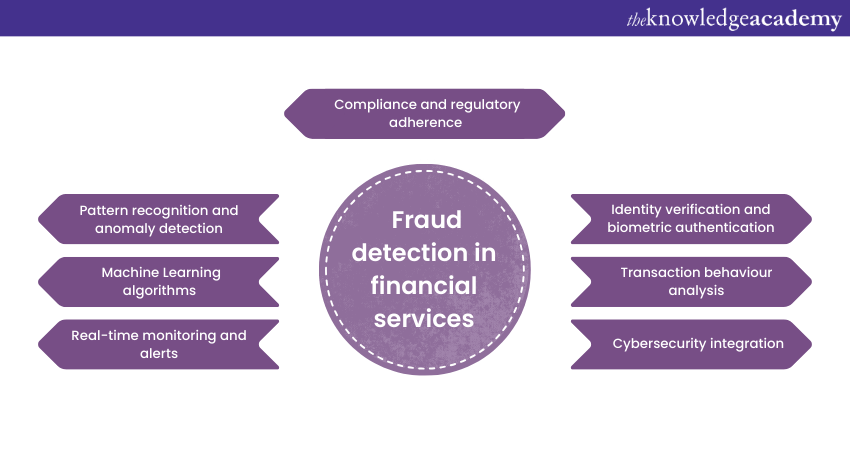
1) Pattern recognition and anomaly detection:
a) Fraud detection systems analyse vast amounts of transaction data to identify patterns indicative of fraudulent behaviour.
b) Anomaly detection algorithms flag transactions that deviate from established patterns, signalling potential fraud for further investigation.
2) Machine Learning algorithms:
a) Machine Learning algorithms continuously learn from historical data, adapting to new fraud patterns and techniques.
b) These algorithms can detect subtle, complex fraud patterns that traditional rule-based systems might miss, ensuring a higher level of accuracy in fraud identification.
3) Real-time monitoring and alerts:
a) Fraud detection systems operate in real time, allowing for instant monitoring of transactions as they occur.
b) Immediate alerts are generated for suspicious activities, enabling rapid response and prevention of fraudulent transactions before they are completed.
4) Identity verification and biometric authentication:
a) Fraud detection includes identity verification measures such as biometric authentication, facial recognition, and fingerprint scans.
b) These technologies ensure that users are who they claim to be, adding an extra layer of security to financial transactions and preventing unauthorised access.
5) Transaction behaviour analysis:
a) By analysing transaction behaviour over time, fraud detection systems can identify changes in spending patterns or transaction locations.
b) Unusual activities, such as transactions from unfamiliar locations or large, atypical purchases, trigger alerts for further scrutiny.
6) Cybersecurity integration:
a) Fraud detection is integrated with cybersecurity measures to safeguard against phishing attacks, data breaches, and malware.
b) Collaborative efforts between fraud detection and cybersecurity teams ensure a holistic approach to fraud prevention, addressing both external and internal threats.
7) Compliance and regulatory adherence:
a) Fraud detection systems aid financial institutions in complying with regulations by monitoring transactions for potential money laundering and other illicit activities.
b) Adherence to regulatory requirements is crucial, and fraud detection systems provide the necessary checks and balances to meet these standards.
Learn more about predictive analysis with our Predictive Analytics Training. Join now!
Smart manufacturing and IoT integration
The integration of intelligent manufacturing with the Internet of Things (IoT) is one of the major proofs of industrial transformation. It helped reshape traditional manufacturing processes into intelligent, data-driven ecosystems. These points will explain how:
1) Predictive maintenance and reduced downtime:
a) IoT sensors embedded in machinery collect real-time data on performance and wear.
b) Predictive algorithms analyse this data, predicting equipment failures before they occur, enabling proactive maintenance and minimising downtime. This predictive approach enhances operational continuity and productivity.
2) Optimised production processes:
a) IoT devices monitor production lines, capturing data on variables such as temperature, pressure, and product quality.
b) Analysing this data in real-time enables manufacturers to identify inefficiencies, adjust processes on the fly, and optimise production for quality and cost-effectiveness, leading to higher yields and reduced waste.
3) Supply chain visibility and inventory management:
a) IoT sensors track the movement of raw materials and finished products throughout the supply chain.
b) This real-time visibility allows manufacturers to optimise inventory levels, anticipate demand, and improve logistics, ensuring that resources are allocated efficiently and reducing excess stock.
4) Quality control and defect prevention:
a) IoT-connected sensors continuously monitor product quality during the manufacturing process.
b) Instant detection of defects or deviations triggers automatic adjustments, reducing the production of faulty goods. This meticulous quality control ensures that only high-quality products reach the market, enhancing customer satisfaction and brand reputation.
5) Energy efficiency and sustainability:
a) IoT devices monitor energy consumption across the manufacturing facility.
b) Smart algorithms analyse the data, suggesting energy-saving measures and optimising resource usage. This focus on energy efficiency not only reduces operational costs but also aligns with sustainable practices, promoting environmental responsibility.
6) Collaborative robotics and workflow optimisation:
a) Smart manufacturing integrates collaborative robots (cobots) into the production process.
b) These cobots work alongside human workers, handling repetitive or dangerous tasks. IoT integration ensures seamless communication between human workers, cobots, and other machines, optimising workflow and increasing overall productivity.
Become an expert in Data Science with our course on Advanced Data Science Certification
Environmental Data Analysis for sustainability
In the face of escalating environmental challenges, leveraging the power of environmental Data Science has become imperative for promoting sustainability and mitigating the impact of climate change. This innovative approach involves the systematic collection, interpretation, and application of vast datasets to address ecological issues, conserve natural resources, and foster a harmonious coexistence between humanity and the environment. The following points will help you to understand better:
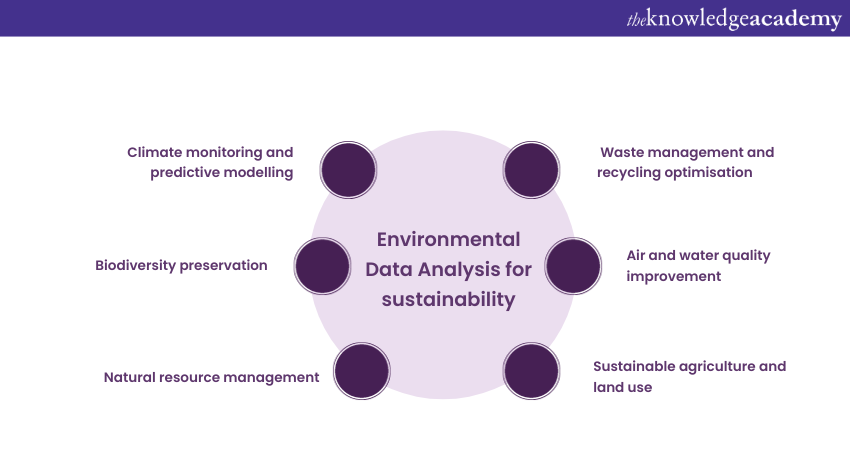
1) Climate monitoring and predictive modelling:
a) Environmental Data Science encompasses climate monitoring and studying long-term weather patterns and changes.
b) Predictive modelling uses this data to anticipate climate shifts, aiding communities in preparing for extreme weather events, such as hurricanes and droughts, and implementing adaptive strategies.
2) Biodiversity preservation:
a) By analysing ecological data, scientists can identify endangered species and at-risk habitats.
b) Conservation efforts are guided by this analysis, enabling the preservation of biodiversity through habitat restoration, protection initiatives, and captive breeding programs.
3) Natural resource management:
a) Environmental Data Analysis optimises the management of natural resources, such as water, forests, and fisheries.
b) Data-driven insights facilitate sustainable usage, ensuring that resources are harvested responsibly and ecosystems are allowed to regenerate naturally, preserving them for future generations.
4) Waste management and recycling optimisation:
a) Analysis of waste production patterns informs efficient waste management strategies.
b) Data-driven recycling programs tailored to specific communities' needs maximise recycling rates, reduce landfill waste, and promote a circular economy.
5) Air and water quality improvement:
a) Environmental Data Analysis identifies sources of air and water pollution, monitoring pollutant levels and their impact on human health.
b) Informed policy decisions, driven by this analysis, lead to the implementation of measures that curb emissions, improve water treatment processes, and enhance overall environmental quality.
6) Sustainable agriculture and land use:
a) Agricultural Data Analysis aids farmers in optimising crop yields while minimising environmental impact.
b) Precision farming techniques, guided by data, promote sustainable agricultural practices, reduce chemical usage, and safeguard soil health.
Predictive maintenance for industrial equipment
Predictive maintenance, a cutting-edge application of Data Science, has emerged as one of the innovative ideas that have revolutionised how industries manage their machinery. By harnessing the power of predictive algorithms and real-time Data Analysis, predictive maintenance ensures that industrial equipment operates at peak efficiency while minimising unexpected downtime and costly repairs.
1) Data-driven predictions:
a) Predictive maintenance utilises sensors and IoT devices to collect vast amounts of data from industrial equipment.
b) Advanced analytics and Machine Learning algorithms process this data, identifying patterns and trends that precede equipment failures. By recognising these early indicators, maintenance activities can be scheduled proactively.
2) Reduced downtime and increased productivity:
a) By predicting when a machine is likely to fail, maintenance can be performed precisely when needed, minimising unplanned downtime.
b) This proactive approach ensures continuous production, maximising operational efficiency and output, which is particularly crucial in industries with stringent production schedules.
3) Cost savings and extended equipment lifespan:
a) Predictive maintenance helps in optimising the usage of spare parts and reduces the need for emergency repairs.
b) By addressing issues before they escalate, businesses save significantly on repair costs, and equipment life is extended, delivering a higher return on investment over the long term.
4) Improved safety and workforce productivity:
a) Well-maintained equipment ensures a safer working environment for employees.
b) Predictive maintenance reduces the need for manual inspections, allowing maintenance staff to focus on higher-value tasks and increasing overall workforce productivity.
5) Condition-based monitoring:
a) Predictive maintenance systems continuously monitor equipment conditions in real-time.
b) Parameters such as temperature, vibration, and pressure are analysed, enabling timely interventions when deviations from optimal operating conditions are detected.
6) Customised maintenance strategies:
a) Predictive maintenance solutions allow businesses to tailor maintenance strategies for different types of equipment.
b) Each machine's unique operational characteristics are considered, ensuring that maintenance activities are precisely calibrated for maximum effectiveness.
Sports analytics and Performance Enhancement
Sports analytics is at the intersection of Data Science and athletics and has fundamentally transformed how teams build strategies, players train, and fans engage with the game. These points will explain briefly how Data Science is being used in sports:
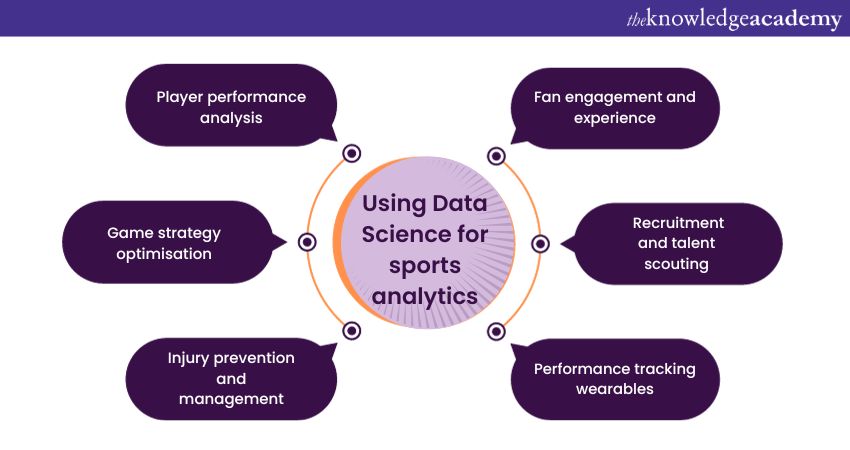
1) Player performance analysis:
a) Sports analytics dissects player performance through metrics like speed, accuracy, endurance, and tactical decision-making.
b) In-depth analysis of player data helps coaches understand their strengths and weaknesses. It also helps the coaches personalise training regimens that focus on enhancing specific skills.
2) Game strategy optimisation:
a) Coaches and teams utilise Data Analysis to study opponents’ past performances, enabling strategic game planning.
b) Predictive modelling helps in anticipating opponents’ moves, adjusting game strategies in real time, and making data-driven decisions during matches.
3) Injury prevention and management:
a) Sports analytics tracks players' biomechanics and movement patterns, identifying potential injury risks.
b) By detecting early signs of strain or fatigue, teams can implement preventive measures, customised training, and recovery plans to reduce injury incidents and enhance player longevity.
4) Fan engagement and experience:
a) Data-driven insights are utilised to enhance fan engagement, offering real-time statistics, interactive apps, and augmented reality experiences.
b) Fans enjoy a more immersive experience, connecting with the game on a deeper level and gaining insights previously available only to professional analysts.
5) Recruitment and talent scouting:
a) Analytics aids in talent scouting by assessing player statistics, skills, and potential.
b) Recruitment decisions are informed by data-driven analysis, ensuring teams invest in athletes who align with their strategic goals and team dynamics.
6) Performance tracking wearables:
a) Wearable devices equipped with sensors collect real-time data on players' vital signs, movements, and performance metrics.
b) This data helps coaches monitor players’ fitness levels during training, games, and recovery, ensuring optimal performance and minimising the risk of overexertion.
Education technology and personalised learning
Education Technology (EdTech) has revolutionised traditional teaching methods, paving the way for personalised learning experiences tailored to individual students' needs and preferences. This transformative approach in education is not just about integrating technology into classrooms but about reshaping the entire learning process to maximise student engagement, comprehension, and academic success. Here’s how Data Science can make a significant contribution to academics:
1) Adaptive learning platforms:
a) EdTech platforms use adaptive algorithms to assess students' strengths and weaknesses.
b) Customised learning paths are created, allowing students to progress at their own pace. Topics challenging for one student might be revisited, while others can delve into advanced materials, ensuring mastery before moving forward.
2) Interactive and engaging content:
a) Digital learning resources, including videos, simulations, and gamified lessons, captivate students' attention.
b) Interactive content fosters active participation, making learning enjoyable and encouraging students to explore topics in-depth.
3) Data-driven insights:
a) Educational apps collect data on students' performance, participation, and understanding of concepts.
b) Educators gain valuable insights into individual progress, enabling timely interventions and personalised feedback, thereby addressing specific learning gaps.
4) Tailored learning paths:
a) Personalised learning platforms analyse students' learning styles and preferences.
b) Lessons are customised to suit visual or auditory learners, ensuring that the content resonates with each student's preferred learning method.
5) Collaborative learning communities:
a) Online forums, collaborative projects, and virtual classrooms create a sense of community among learners.
b) Students can engage in discussions, share ideas, and collaborate with peers globally, fostering diverse perspectives and enhancing critical thinking skills.
6) Teacher support and professional development:
a) EdTech provides resources for teachers, aiding in lesson planning, assessment creation, and classroom management.
b) Professional development opportunities enable educators to stay updated on the latest teaching methodologies and technology, enhancing their effectiveness in the digital classroom.
Cybersecurity threat analysis
Cybersecurity threat analysis involves the systematic examination of digital systems, networks, and applications to identify vulnerabilities and anticipate potential security breaches. Here's how it plays a pivotal role in safeguarding our digital frontiers:
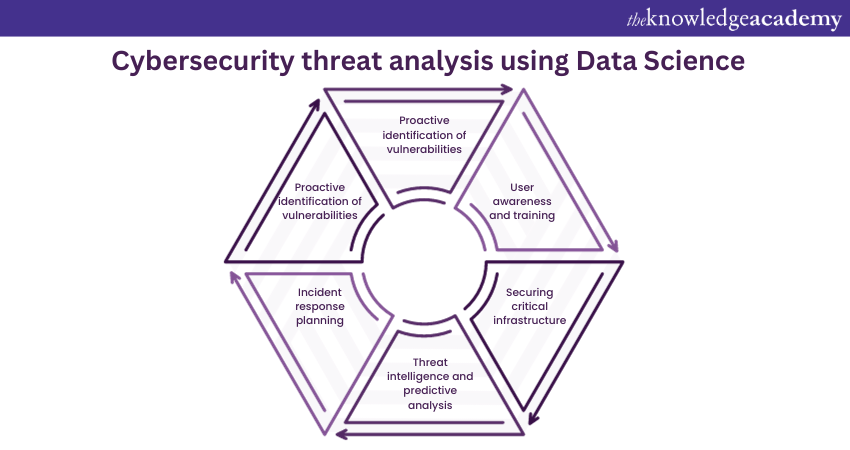
1) Proactive identification of vulnerabilities:
a) Cybersecurity threat analysis involves identifying potential vulnerabilities in software, networks, and systems.
b) Through rigorous testing and examination, cybersecurity professionals uncover weaknesses before malicious actors exploit them, enabling organisations to fortify their defences.
2) Behavioural analytics and anomaly detection:
a) Advanced cybersecurity tools employ behavioural analytics and machine learning algorithms to establish a baseline of normal user behaviour.
b) Any deviations from this norm, indicative of a potential cyber threat, trigger alerts, allowing swift action to mitigate the threat and prevent unauthorised access.
3) Incident response planning:
a) Cybersecurity threat analysis assists organisations in formulating comprehensive incident response plans.
b) By analysing threat intelligence data, organisations can anticipate potential attacks, enhancing their ability to defend against new and evolving threats proactively.
4) Threat intelligence and predictive analysis:
a) Cybersecurity professionals constantly monitor global cyber threats and emerging attack patterns.
b) By analysing threat intelligence data, organisations can anticipate potential attacks, enhancing their ability to proactively defend against new and evolving threats.
5) Securing critical infrastructure:
a) Cybersecurity threat analysis is essential for safeguarding critical infrastructure, such as power grids, transportation systems, and healthcare networks.
b) A breach in these sectors can have severe consequences. Therefore, meticulous analysis and fortification of these systems are imperative for national security.
6) User awareness and training:
a) Cybersecurity threat analysis aids in understanding common attack vectors and techniques employed by cybercriminals.
b) This knowledge is used to educate users and promote cybersecurity awareness and best practices, reducing the likelihood of falling victim to phishing attempts or social engineering attacks.
Want to become more familiar with R programming? Sign up now for our Data Science with R Training
Conclusion
We hope that you have some ideas on how to use Data Science for your business. In this blog, we discussed these ten innovative Data Science Business Ideas that are reshaping industries and creating new avenues for growth. As companies continue to recognise the power of Data Science, you can leverage such ideas and bring transformative solutions in your respective fields.
Enhance your knowledge of Blockchain technology with our Data Science and Blockchain Training. Join now!
Frequently Asked Questions
Upcoming Data, Analytics & AI Resources Batches & Dates
Date
 Python Data Science Course
Python Data Science Course
Mon 6th Jan 2025
Mon 24th Mar 2025
Mon 26th May 2025
Mon 28th Jul 2025
Mon 20th Oct 2025
Mon 1st Dec 2025







 Top Rated Course
Top Rated Course


 If you wish to make any changes to your course, please
If you wish to make any changes to your course, please


